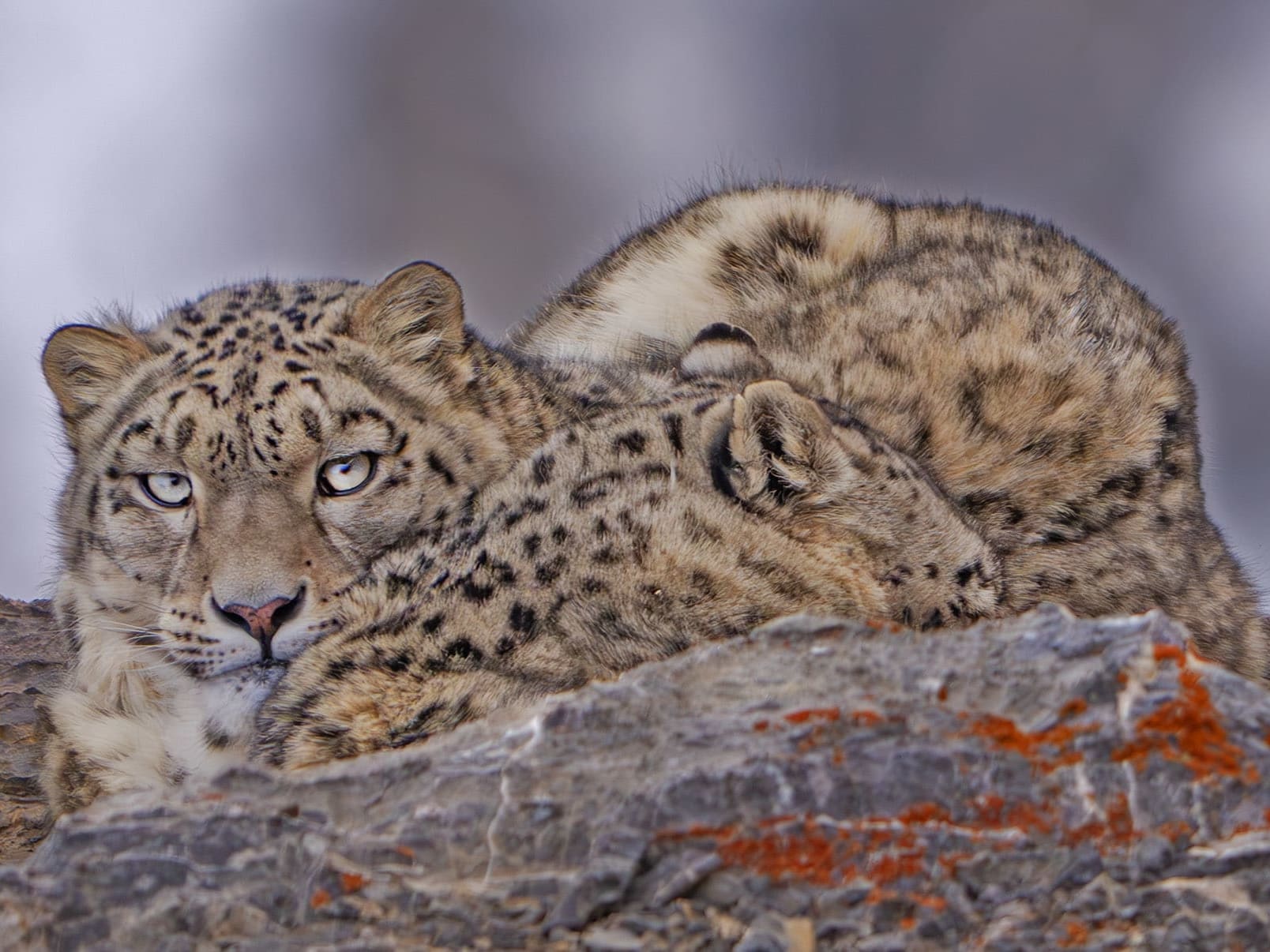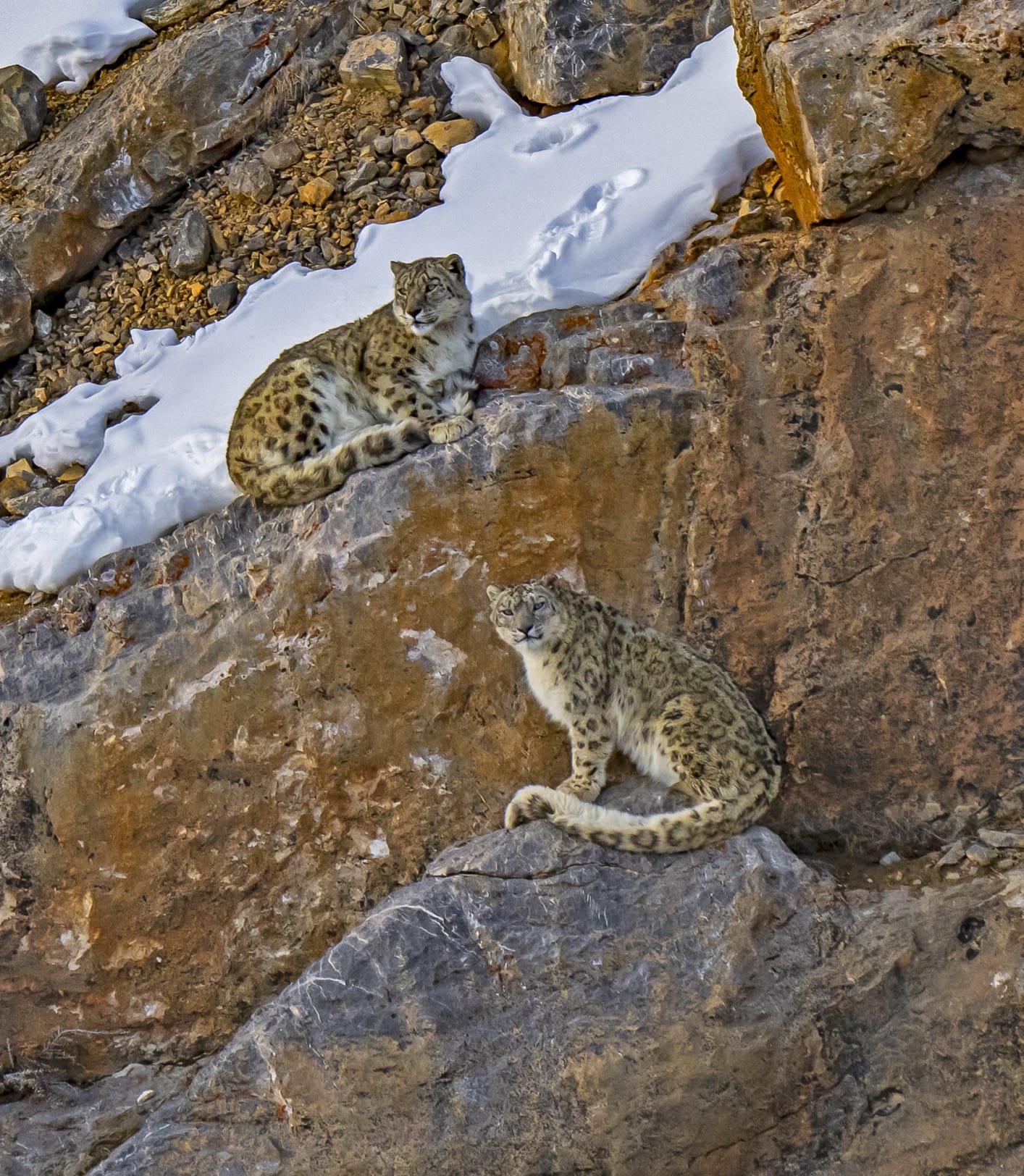 Listen to this article
•
15:34 min
Listen to this article
•
15:34 min
On a bitingly cold February afternoon in 2022, at –25 degrees Celsius, Kalzang Gurmet, field manager for Nature Conservation Foundation (NCF) in Spiti, sat cross-legged on a floor mattress in our unpretentious homestay. We were in Kibber, a high-altitude village in Spiti, 4,200 m above sea level. The warmth of the bukhari enveloped us like a warm hug as we huddled closer to it. Amidst cups of milky tea and phone calls about potential snow leopard sightings, Kalzang told me a story I will never forget.
In 2020, a male snow leopard died close to the village of Kibber. He had strayed into the village a few days earlier, had his fill of livestock, and passed away gently in the vicinity of the village he probably thought of as home. In Kibber, the villagers gathered not with resentment over lost livestock, but with reverence — mourning the snow leopard as a cherished presence on their land. They joined in his cremation, offering Buddhist prayers and a traditional scarf, a tribute kept for the most honoured of beings. Over the last few decades, Kibber has led the way and become a model of human-carnivore coexistence. But it was not always this way.
In the 1990s, a snow leopard entered the livestock pen of a homestay in Kibber. As is typical when it enters a livestock pen, the cat killed around 15-20 goats and sheep. The woman of the house entered the pen in the morning to get milk. To her horror, she found the snow leopard sleeping inside, next to the dead livestock, and quickly latched the door. Livid, she informed the rest of her family and neighbours. The villagers started gathering in large numbers — anger mounting with every new arrival. Each of them had their own snow leopard story. Consumed by resentment and anger, they brought weapons, knives and ropes. The snow leopard was killed.
The communities living in the Upper Spiti landscape are mostly Tibetan Buddhists and largely agro-pastoral. Most pastoral communities, since they rely on livestock for their livelihood, have always been antagonistic towards predators. Attacks by predators like the snow leopard and wolves resulted in huge financial losses, so the resentment was natural and retaliatory persecution frequent. For nearly 25 years, Tanzin Thinley, field manager at NCF and Kibber resident, has worked with the community to mitigate this conflict. “When I was growing up, the antagonism was really intense,” said Thinley. “Community members would go looking for wolf dens. They would smoke the dens, kill wolves and bring back the pups. The pups would be used as evidence to prove that they had killed the adults. They would carry them from house to house across villages and demand compensation for ‘preventing future losses’. We conducted a survey in 2003-04 to understand people’s attitudes towards predators, particularly snow leopards. At Kibber, nearly thirty per cent thought complete eradication of snow leopards was necessary.”
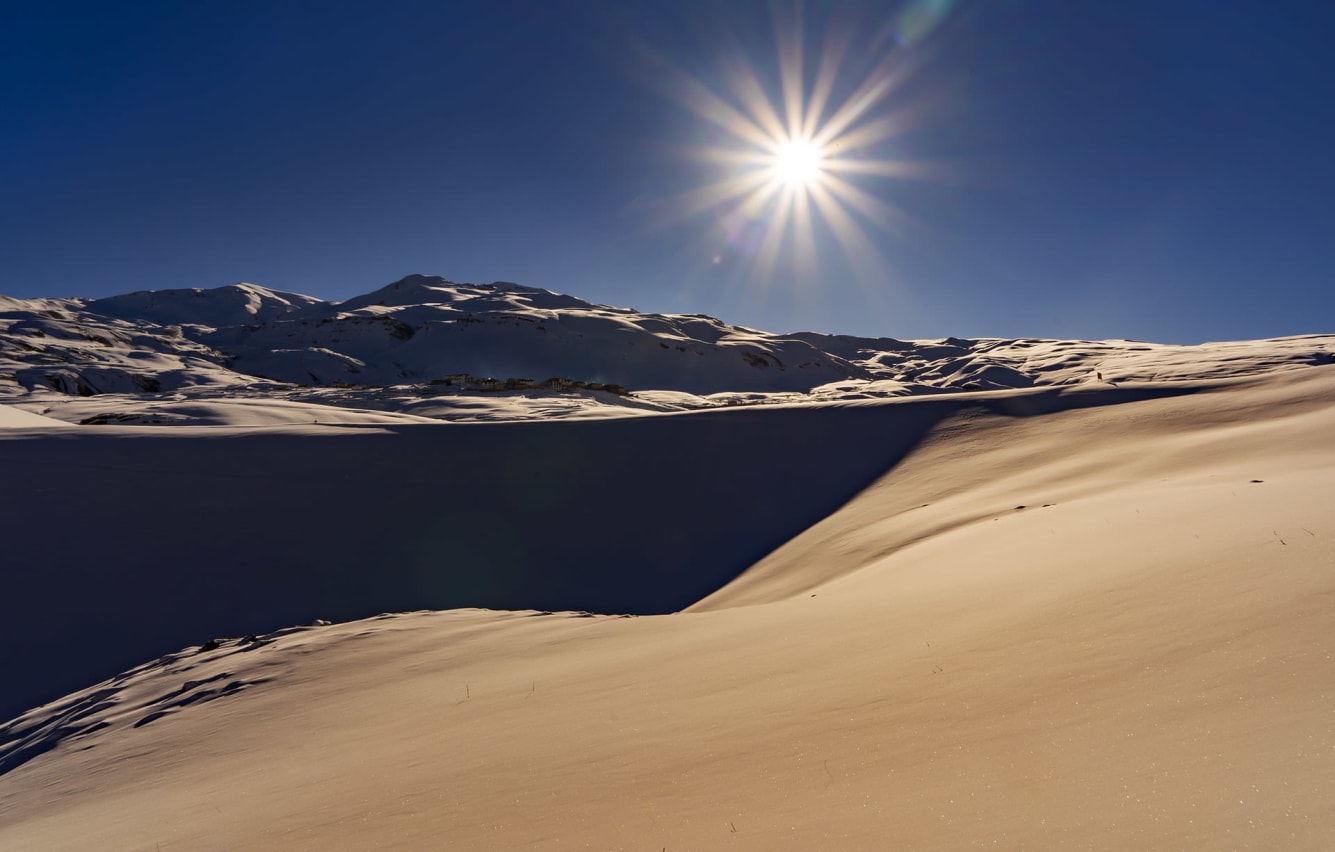
Cover photo: The snow leopard inhabits some of the world’s most rugged heights. Found anywhere from about 600 to 5,000 m, these mountain cats survive in some of the coldest, most remote ranges on the planet.
In the late 80s and 90s, Spiti’s economy was still driven by livestock rearing and barley farming, with a barter system sustaining life. Ladakh’s Changpa pastoralists arrived with carpets, Chinese-made goods, and wool to swap for barley, and Spitians took their prized Chamurthi horses to Changthang. Later, some higher villages began harvesting green peas as a cash crop, a shift that nudged the valley toward a money-based economy. Roads were poor, phones rare, and there was, of course, no Internet.
It was during this time, in 1996, that PhD student Charudutt Mishra first arrived in Upper Spiti to study mountain herbivores. At the time, he wouldn’t have imagined that his interventions — combined with the community’s commitment — would transform coexistence in the landscape and create one of India’s great conservation triumphs.
“At the time, the community relied heavily on livestock, hence all the pastures were severely overgrazed. Consequently, my PhD examined the competition for food between livestock and wild herbivores, especially blue sheep,” Mishra said on a video call from Bengaluru. Wild herbivore populations were declining because of this competition. Mishra proposed an experiment to the Kibber community: that they set aside part of their pasture land for wild animals and not graze livestock there. These areas would be called village reserves. The community agreed, and something unexpected happened.
Blue sheep found these undisturbed areas with abundant food and moved there, leading to a steep increase in their numbers. Interestingly, another consequence of this experiment was that snow leopards — the enigmatic cats — that even locals had only fleetingly seen in the past, began to frequent the Kibber landscape. It was not just blue sheep, the phantom of the precipices had also found a safe space in a village in Upper Spiti.
The success of the grazing reserves sparked new questions in Mishra’s mind. Even if it went beyond the purview of his PhD, he knew he had to turn his attention to the cats — to their predation of livestock, and the uneasy relationship they shared with the people of Spiti. So began Mishra’s relationship with the snow leopard and over three decades of conservation work. Today, as Founder-Trustee of NCF and Executive Director of the International Snow Leopard Trust, he has been honoured with international awards, including by the Whitley Fund for Nature, for his efforts to protect the cat and involve local communities across its 12-country range. Yet, for him, everything began in Kibber.
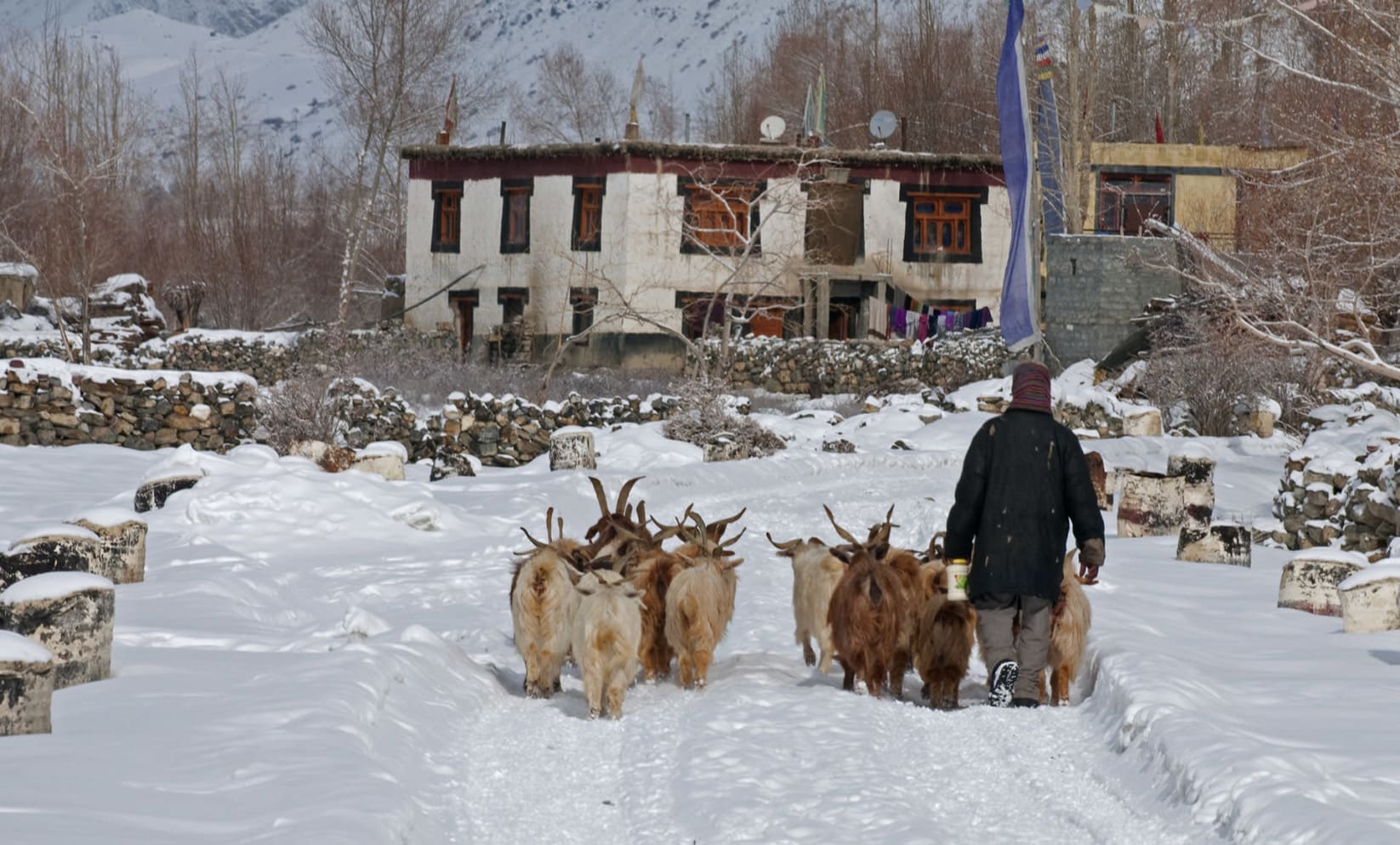
“The people of Kibber thought of snow leopards as pests. I realised that to truly understand the extent of this conflict, I needed to understand the people and the landscape better,” said Mishra.
His deep understanding of the local conflict with wild predators made way for the first community-managed livestock insurance programme in 2002. While the state’s compensation system (which pays pastoralists for loss of livestock to predator killings) was in place, it frequently failed to cover the scale of loss. “By my estimates, the community was losing 12 per cent of livestock to snow leopards and wolves, but only being compensated on average for a mere 3 per cent of the financial loss. Additionally, compensation programmes tend to reinforce the idea that it is someone else’s problem that people are being compensated for. Our idea was to support the community in taking charge of and managing their own problems,” Mishra said. His experience in conflict resolution is clearly a useful skill in his Bengaluru home as well, where he gently but effectively tried to dissuade his dog from eating the cat’s food during our video call.
The livestock insurance programme was the first project Thinley worked on when he joined Mishra’s efforts. Thinley points out that although this programme has its own set of challenges, they often push the organisation and community to come up with workable solutions.
Reinforcing corrals or livestock pens is another innovative measure that has reduced livestock predation and, in turn, reduced the retaliatory killing of predators. Livestock are kept in pens in every traditional Spitian household. These are often flimsy, unfortified structures that predators can easily breach. Snow leopards take advantage of the frailty of these structures and enter corral pens. When they get access to the corrals, it often results in mass livestock mortality inside the pen. The enclosed space leads them to kill far more than they can eat. An attack like this could potentially wipe out the herder’s income in one night. “An attack like this also increases the chance of the snow leopard being attacked and killed. The simple idea, to collaboratively reinforce and predator-proof these livestock pens, has helped protect the livestock, the community’s financial stability, and the lives of snow leopards. It’s a win-win for everyone,” says Thinley, adding that community work only succeeds if it’s embedded in daily life.
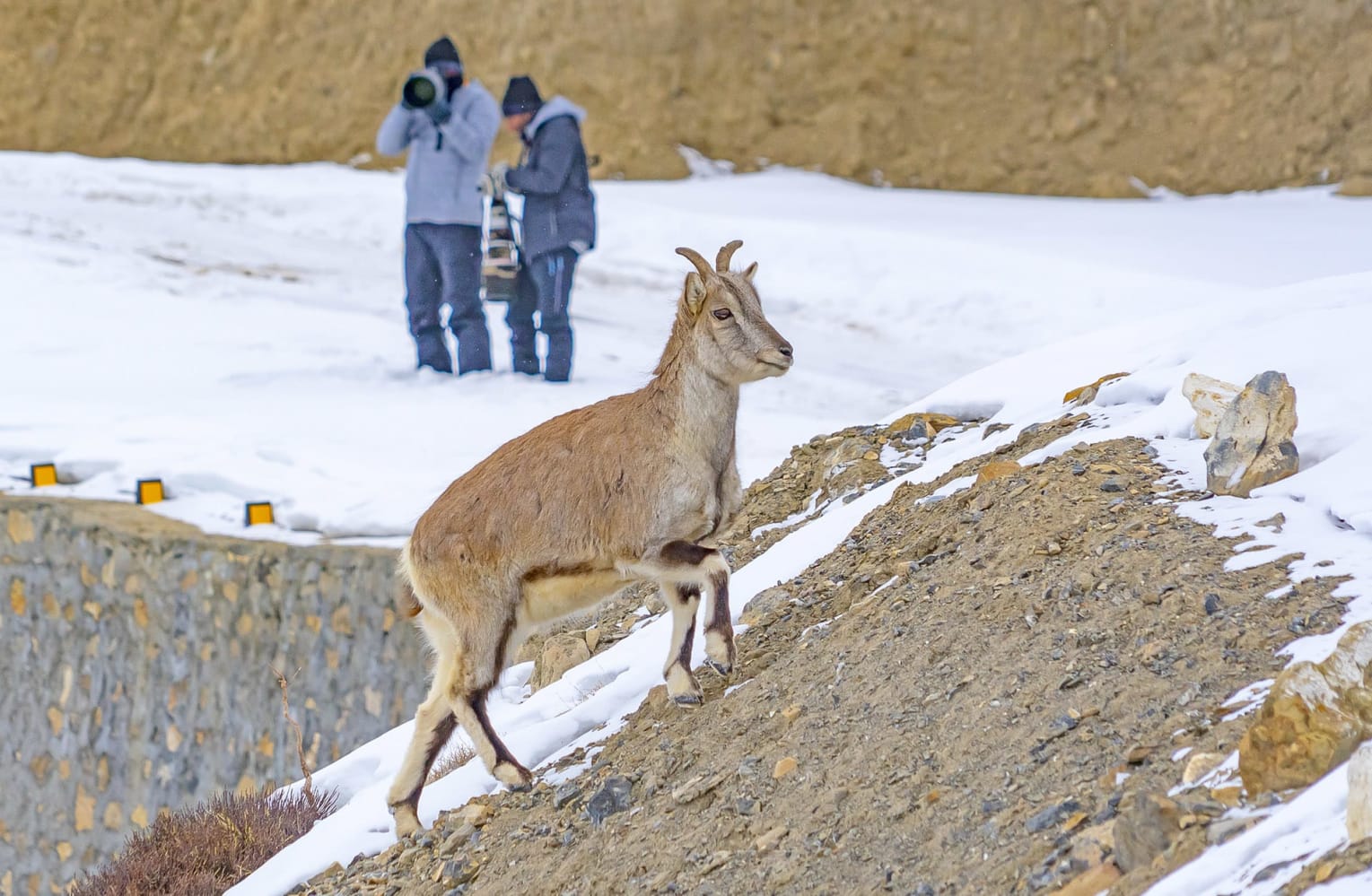
With the increase in blue sheep presence, Kibber had become one of those rare places in the world where snow leopards could be spotted at eye level in the winter. This increased visibility of the snow leopards made the community, already catering to summer tourists, realise that, despite the sub-optimal winter weather, wildlife tourism could be a reality. The idea was encouraged by some tourist outfitters and supported by organisations like NCF, which provided naturalist and tourism training. The village already had a few homestays. Slowly, more tourists started visiting in winter in the hope of catching a glimpse of one of the world’s most mysterious cats. By 2014, a breed of wildlife enthusiasts, photographers and filmmakers began to see the beauty and allure of white, sub-zero winters at Kibber. The sightings that followed in the next few years set off a ripple of excitement among the wildlife community. “I saw my first snow leopard ten years after I first landed in Spiti; travellers are now seeing snow leopards on their first trip, even their first day!” laughed Mishra, shrugging his shoulders. A snow leopard peered at me from his Zoom background.
When Mishra first arrived, there were only one or two homestays in Kibber. Today, of the 80 houses, 46 are homestays in the winter. Winter tourism has also picked up for nearby villages like Chichim and Langza, and created a ripple effect on towns like Kaza at lower elevations. Mishra shares that estimates from a few years ago indicate that Kibber alone makes Rs 1.25 crores in the 2-3 winter months each year. The tourism model has been successful in Upper Spiti because the entire community shares the profit in one way or another. “Mountain communities are very closely knit,” said Thinley, “we share our joys and our grief. That has always held us in good stead. The profits from tourism don’t just go to the homestay owners; people from the community are now trained as trackers or guides. Some work as porters. The widows in the village are also included — their yaks are used to take tourists closer to the snow leopards.”
The women of the village who used to spend their winters brewing local beer, looking after livestock, and making small handicrafts for home use were roped in by the NCF with the idea that their handicrafts could become a source of income. Women began knitting mufflers, socks, gloves, and even snow leopard–themed merchandise, which soon found eager buyers among visitors staying at local homestays. Over time, their work expanded beyond Spiti, finding a foothold in national markets such as the Dastkari Haat in Delhi. And when the pandemic hit, cutting off external support, the women adapted swiftly. They started going door-to-door at homestays, meeting tourists directly and selling their wares with confidence. What began as a small intervention had grown into a self-sustaining enterprise — powered by the women’s own skill and ingenuity. Tourism has fuelled the winter economy of Upper Spiti. And this has played a significant role in changing people’s attitudes towards the snow leopard.

I recall what Lara Tsering, Langza resident, tour operator, and guide for my 2022 trip to Spiti, had told me as I was labouring my way breathlessly through the snow to see my first snow leopard. “Snow leopard tourism has changed winters in Spiti. It has positively impacted the lives of a large group of people. We used to think of the snow leopard as a demon at one point; we now think of it as a benevolent God.”
I stood at the edge of a steep precipice wearing four layers, a balaclava, and gloves. The wind was still piercing through the layers into my body. I had stood in ankle-deep snow for over three hours. Tsering constantly reminded me to keep moving my hands and feet to prevent frostbite. I faced another vertical cliff — with a valley between us — where there were not one, but two snow leopards. A mating pair. I had arrived in Kibber just that morning, and my brain was still frozen from the windchill. And yet, thanks to the incredible network of trackers and guides, here I was already face-to-face and breathing the same air as this gorgeous spectral cat. I was struck with awe and gratitude. Mishra may have taken ten years to see his first snow leopard, but thanks to him, Thinley, Kalzang, and everyone else who has worked to conserve this species, I had the privilege of spotting it on the day I arrived.
Three years on, the cliffs, the snow, and the leopards are still hauntingly present in my mind.
A version of this story was first commissioned by Frontline Magazine and published in the November 30, 2025 issue.



